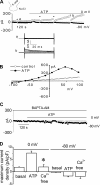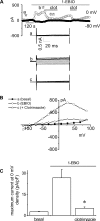Identification and functional characterization of the intermediate-conductance Ca(2+)-activated K(+) channel (IK-1) in biliary epithelium
- PMID: 20501432
- PMCID: PMC2777461
- DOI: 10.1152/ajpgi.00223.2009
Identification and functional characterization of the intermediate-conductance Ca(2+)-activated K(+) channel (IK-1) in biliary epithelium
Abstract
In the liver, adenosine triphosphate (ATP) is an extracellular signaling molecule that is released into bile and stimulates a biliary epithelial cell secretory response via engagement of apical P2 receptors. The molecular identities of the ion channels involved in ATP-mediated secretory responses have not been fully identified. Intermediate-conductance Ca(2+)-activated K(+) channels (IK) have been identified in biliary epithelium, but functional data are lacking. The aim of these studies therefore was to determine the location, function, and regulation of IK channels in biliary epithelial cells and to determine their potential contribution to ATP-stimulated secretion. Expression of IK-1 mRNA was found in both human Mz-Cha-1 biliary cells and polarized normal rat cholangiocyte (NRC) monolayers, and immunostaining revealed membrane localization with a predominant basolateral signal. In single Mz-Cha-1 cells, exposure to ATP activated K(+) currents, increasing current density from 1.6 +/- 0.1 to 7.6 +/- 0.8 pA/pF. Currents were dependent on intracellular Ca(2+) and sensitive to clotrimazole and TRAM-34 (specific IK channel inhibitors). Single-channel recording demonstrated that clotrimazole-sensitive K(+) currents had a unitary conductance of 46.2 +/- 1.5 pS, consistent with IK channels. In separate studies, 1-EBIO (an IK activator) stimulated K(+) currents in single cells that were inhibited by clotrimazole. In polarized NRC monolayers, ATP significantly increased transepithelial secretion which was inhibited by clotrimazole. Lastly, ATP-stimulated K(+) currents were inhibited by the P2Y receptor antagonist suramin and by the inositol 1,4,5-triphosphate (IP3) receptor inhibitor 2-APB. Together these studies demonstrate that IK channels are present in biliary epithelial cells and contribute to ATP-stimulated secretion through a P2Y-IP3 receptor pathway.
Figures









Similar articles
-
Extracellular nucleotides stimulate Cl- currents in biliary epithelia through receptor-mediated IP3 and Ca2+ release.Am J Physiol Gastrointest Liver Physiol. 2008 Nov;295(5):G1004-15. doi: 10.1152/ajpgi.90382.2008. Epub 2008 Sep 11. Am J Physiol Gastrointest Liver Physiol. 2008. PMID: 18787062 Free PMC article.
-
K(Ca)3.1 channels facilitate K+ secretion or Na+ absorption depending on apical or basolateral P2Y receptor stimulation.J Physiol. 2011 Jul 15;589(Pt 14):3483-94. doi: 10.1113/jphysiol.2011.207548. Epub 2011 May 23. J Physiol. 2011. PMID: 21606112 Free PMC article.
-
P2Y receptor regulation of sodium transport in human mammary epithelial cells.Am J Physiol Cell Physiol. 2007 Nov;293(5):C1472-80. doi: 10.1152/ajpcell.00068.2007. Epub 2007 Aug 22. Am J Physiol Cell Physiol. 2007. PMID: 17715387
-
The Ca2+-activated K+ channel of intermediate conductance: a molecular target for novel treatments?Curr Drug Targets. 2001 Dec;2(4):401-22. doi: 10.2174/1389450013348173. Curr Drug Targets. 2001. PMID: 11732639 Review.
-
Recent Advances in Ionic Mechanisms in Pituitary Cells: Implications for Electrophysiological and Electropharmacological Research.J Clin Med. 2025 Apr 30;14(9):3117. doi: 10.3390/jcm14093117. J Clin Med. 2025. PMID: 40364147 Free PMC article. Review.
Cited by
-
Luminal cholinergic signalling in airway lining fluid: a novel mechanism for activating chloride secretion via Ca²⁺-dependent Cl⁻ and K⁺ channels.Br J Pharmacol. 2012 Jun;166(4):1388-402. doi: 10.1111/j.1476-5381.2012.01883.x. Br J Pharmacol. 2012. PMID: 22300281 Free PMC article.
-
Potassium channels in pancreatic duct epithelial cells: their role, function and pathophysiological relevance.Pflugers Arch. 2015 Apr;467(4):625-40. doi: 10.1007/s00424-014-1585-0. Epub 2014 Jul 31. Pflugers Arch. 2015. PMID: 25074489 Review.
-
Adenosine triphosphate release and purinergic (P2) receptor-mediated secretion in small and large mouse cholangiocytes.Hepatology. 2010 Nov;52(5):1819-28. doi: 10.1002/hep.23883. Hepatology. 2010. PMID: 20827720 Free PMC article.
-
Identification and functional characterization of TMEM16A, a Ca2+-activated Cl- channel activated by extracellular nucleotides, in biliary epithelium.J Biol Chem. 2011 Jan 7;286(1):766-76. doi: 10.1074/jbc.M110.164970. Epub 2010 Nov 1. J Biol Chem. 2011. PMID: 21041307 Free PMC article.
-
K(Ca)2 channels: novel therapeutic targets for treating alcohol withdrawal and escalation of alcohol consumption.Alcohol. 2012 Jun;46(4):309-15. doi: 10.1016/j.alcohol.2011.11.002. Epub 2012 Mar 30. Alcohol. 2012. PMID: 22464787 Free PMC article. Review.
References
-
- Barfod ET, Moore AL, Roe MW, Lidofsky SD. Ca2+-activated IK1 channels associate with lipid rafts upon cell swelling and mediate volume recovery. J Biol Chem 282: 8984–8993, 2007 - PubMed
-
- Basavappa S, Middleton JP, Mangel A, McGill J, Cohn JA, Fitz JG. Cl− and K+ transport in human biliary cell lines. Gastroenterology 104: 1796–1805, 1993 - PubMed
-
- Cohn JA, Strong TA, Picciotto MA, Nairn AC, Collins FS, Francis S, Fitz JG. Localization of CFTR in human bile duct epithelial cells. Gastroenterology 105: 1857–1864, 1993 - PubMed
Publication types
MeSH terms
Substances
Grants and funding
LinkOut - more resources
Full Text Sources
Miscellaneous

